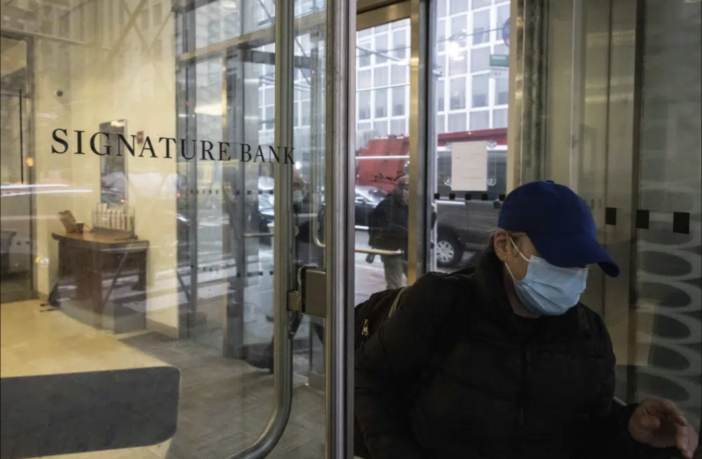Recent turmoil in the banking industry may have you worried about your money.
The recent collapses of Silicon Valley Bank and Signature Bank, which catered mostly to the tech industry, were the second- and third-biggest bank failures in U.S. history.
It started when too many depositors tried to withdraw their money from Silicon Valley Bank in Santa Clara, California. That’s known as a bank run.
The bank had to sell treasury bonds and other securities at a steep loss and more people kept trying to withdraw money as word of the situation spread, causing the bank to fail. Regulators took control of New York-based Signature Bank soon after, saying it was necessary to protect depositors after too many people withdrew money.
In response, regulators guaranteed all deposits at the two banks and created a program to help shield other banks to shield them from a run on deposits.
Over the weekend, authorities in Switzerland said UBS Bank would acquire Credit Suisse, a smaller rival that’s one of 30 banks classified as globally significant because it could pose a risk of bigger trouble if it collapses. It had problems that predated the problems at the U.S. banks.
Here’s what you need to know:
IS MY MONEY SAFE?
Yes, if your money is in a U.S. bank insured by the Federal Deposit Insurance Corp. and you have less than $250,000 there. If the bank fails, you’ll get your money back.
Nearly all banks are FDIC insured. You can look for the FDIC logo at bank teller windows or on the entrance to your bank branch.
Credit unions are insured by the National Credit Union Administration.
If you have over $250,000 in individual accounts at one bank, which most people don’t, the amount over $250,000 is considered uninsured and experts recommend that you move the remainder of your money to a different financial institution, said Caleb Silver, editor in chief of Investopedia, a financial media website.
If you have multiple individual accounts at the same bank, for example a savings account and certificate of deposit, those are added together and the total is insured up to $250,000. (Read on for more about how joint accounts are protected.)
Federal officials have been taking steps to make sure other banks aren’t impacted.
“You shouldn’t be too concerned about your money if it’s in one of the bigger banks, and even in some of the regional banks and the credit unions,” Silver said.
CAN I TELL IF MY BANK WILL FAIL?
If you are worried about your bank closing in the near future, there are some things you can watch out for, according to Silver:
Watch the stock price.
Keep an eye on the quarterly and annual reports from your bank.
Start a Google alert for your bank in case there are news stories about it.
You want to make sure you pay close attention to the way your bank is behaving, Silver said.
“If they’re trying to raise money through a share offering or if they’re trying to sell more stock, they might have trouble on their balance sheet,” said Silver.
SHOULD I LOOK FOR ALTERNATIVES?
If you have more than $250,000 in your bank, there are a few things you can do:
You can protect up to $500,000 by opening a joint account with someone else, such as your spouse, said Greg McBride, chief financial analyst at Bankrate, a financial services company.
“A married couple can easily protect a million dollars at the same bank by each having an individual account and together having a joint account,” McBride said.
Move to another financial institution
Moving your money to other financial institutions and having up to $250,000 in each account will ensure that your money is insured by the FDIC, McBride said.
Despite the recent uncertainty, experts don’t recommend withdrawing cash from your account. Keeping your money in financial institutions rather than in your home is safer, especially when the amount is insured.
“It’s not a time to pull your money out of the bank,” Silver said.
Even people with uninsured deposits usually get nearly all of their money back.
“It takes time, but generally all depositors — both insured and uninsured — get their money back,” said Todd Phillips, a consultant and former attorney at the FDIC. “Uninsured depositors may have to wait some time, and may have to take haircut where they lose 10 to 15% of their savings, but it’s never zero.”
HOW LONG DOES IT TAKE FOR INSURED MONEY TO BE AVAILABLE IF A BANK FAILS?
Historically, the FDIC says it has returned insured deposits within a few days of a bank closing. The FDIC will either provide that amount in a new account at another insured bank or issue a check.
HOW MUCH MONEY CAN BE INSURED IN JOINT ACCOUNTS?
If you have a joint account, the FDIC covers each individual up to $250,000. You can have both joint and single accounts at the same bank and be insured for each.
So if a couple each has individual accounts and a joint account where they have equal withdrawal rights, they can each have up to $250,000 insured in their single accounts and up to $250,000 in their joint accounts. That means each of them will have up to $500,000 insured.
WHAT ABOUT OTHER INVESTMENTS?
Customers should take a close look at the types of investments they have in their bank to know how much of their assets are insured by the FDIC. The FDIC offers an Electronic Deposit Insurance Estimator, a tool to know how much of your money is insured per financial institution.
FDIC deposit insurance covers:
— Checking accounts — Negotiable Order of Withdrawal (NOW) accounts — Savings accounts — Money Market Deposit Accounts (MMDAs) — Certificates of Deposit (CDs) — Cashier’s checks — Money orders — Other official items issued by an insured bank
FDIC deposit insurance doesn’t cover:
— Stock investments — Bond investments — Mutual funds — Life insurance policies — Annuities — Municipal securities — Safe deposit boxes or their contents — U.S. Treasury bills, bonds, or notes — Crypto assets
HOW DOES A CREDIT UNION COMPARE TO A BANK?
Both credit unions and banks allow customers to open savings and checking accounts, among other financial products.
The key difference is that credit unions are not-for-profit institutions, which tends to translate into lower fees and lower balance requirements, while banks are for-profit. Sometimes it also means that it’s easier for credit union customers to be approved for loans, McBride said.
Usually, customers are allowed to join credit unions based on where they live or work.
Credit unions serve a smaller number of customers, which also allows for a more personalized experience. The tradeoff is that banks tend to have larger staff, more physical branches and newer technology.
When it comes to the safety of customer’s money, both banks and credit unions insure up to $250,000 per individual customer. While banks are insured by the FDIC, credit unions are insured by the NCUA.
“Whether at a bank or a credit union, your money is safe. There’s no need to worry about the safety or access to your money,” McBride said.



